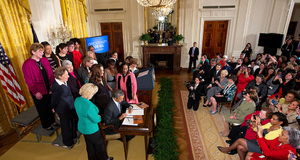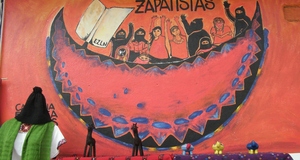The Political Returns of Philanthropy: The Case of Tammany Hall
By
2012, Vol. 4 No. 05 | pg. 2/2 | « A second marginalized group who received a distinct measure of upward mobility from the WCTU were the participant women themselves. WCTU members in Michigan, for example, forged one such opportunity when they successfully lobbied for a state bill to build a girl’s reformatory. The bill, passed in 1879, specifically stipulated that women should comprise a majority on the institutions board of directors. As such, members of the WCTU created for themselves an in-road to become the first women to hold public office in that state. Prior to this type of movement, women had been confined to a traditional sphere comprised of the home and care of children. While it was the responsibility for protection of home and family that initially catalyzed the women of the WCTU to move outside of their traditional roles, expansion of women’s influence eventually led them to the workplace and into political discourse, thereby constituting upward social mobility as consequence of charitable actions. Using creative philanthropy, they had, according to Ann Frior Scott “[closed the] loophole in the common-law doctrine of civil death for married woman.”13 Despite the general inability of the WCTU to provide upward financial mobility, there were exceptions. For instance, some union chapters included resources like vocational schools for industrial workers.14 However, due to prohibitive cost, programs like this were few and far between. In this sense, Mckitrick’s conception of upward mobility is less applicable since employment assistance had less of an overall effect on the WCTU than the other avenues for upward mobility that the organization engendered. However, upward social mobility, enjoyed by both WCTU participants and the populations that they served, emerged as a central component of the organization’s lasting successes. Within the realm of justice, Women in the nineteenth century were, relative to men, relegated to second-class status and, therefore, were unable to exercise influence over government and law enforcement to the same extent as Tammany had. Despite this incongruence, women capitalized on their unique purview over moral issues, in order to foster a different type of justice. Historian Keith Melder noted that, through the expansion of the doctrine of separate spheres, to include moral reform in the public realm, women had secured moral authority over men.15 Using this authority, the WCTU promoted social justice.Unlike the political machines whose aid was token and intended to keep the poor on the dole, women sought to ameliorate the lives of those with whom they worked with in a significant and meaningful way. Moreover, while early women’s reform movement were notorious for differentiating between the worthy and unworthy poor, the WCTU, early in its history, identified Alcoholism as a disease and therefore a cause and result of social problems.16 In light of this progressive conception, the WCTU was invested in preemptively stamping out alcoholism to prevent future social unrest, rather than abandoning its victims as unworthy. Therefore, within the consciousness of the Women’s Christian Temperance Union, social justice was inherent because it kept the idea of equality alive for poor immigrants who had suffered extreme marginalization. The existence of such parity between two groups that were so dissimilar at first seems counterintuitive. But, it can be understood when examined through the lens of the like conditions that gave rise to each. In light of identical conditions such as, burgeoning immigration, an unprecedented number of poor who could not support their families, and the absence of any significant governmental attempt to address these problems, Tammany Hall and the Women’s Christian Temperance Union both appear to be have been highly responsive institutions. They developed in similar directions as consequence of social issues in era they lived. Their rhetoric and intentions, to gain political eminence and stamp out alcoholism, respectively, seem to be secondary developmental factors that would have lacked efficacy without the added component of rapid response to social need. Also, the end result of the common set of conditions shared by these two groups was their ability to create for themselves access to upward mobility, in social and political realms, because of their philanthropic activities. When related to Tammany politicians, this was clearly the intended effect of welfare programs and work with immigrants. For the WCTU, the intention to reap profit may not have been present. But by positioning themselves to fulfill essential societal roles, they inadvertently gained some measure of both professional and political credibility. It is worth noting that these two groups were not the only organizations that successfully capitalized on charity to further some type of political goal. Other nineteenth century organizations, notable for the use of charity to curry favor and gain popular or political support are labor unions and social bandits, like the Jesse James gang.17 Yet this tactic transcends century and nation, and therefore can be seen in insurgent movements throughout time. Even in the study of contemporary political science, scholars have continued examining how systematic relief efforts can undercut the efficacy of insurgent movements, further highlighting the significance that situation and context plays in the emergence of insurgent movements like those in the Middle East or, quasi-insurgent movements, like Tammany and the WCTU.19 1.) Oliver E. Allen, The Tiger. (New York: Addison-Wesley Publishing Company, 1993), 36. 2.) Anne F. Scott, Natural Allies. (Chicago: University of Illinois Press, 1991), 25. Anne Firor Scott notes the government’s inability to care for the emerging poor as a primary factor behind the emergence of benevolent societies. Tammany, along with the other groups noted in this study, all benefited from the government’s ineptitude. 3.) Erik L. McKitrick, "Study of Corruption." Political Science Quarterly 72, no. 4 (1957), 505 4.) Ibid. 23-4 5.) Robert Ernst, Immigrant Life in New York City, (Port Washington, Ira J. Friedman Inc.), 163 6.) Tyler Anbinder, Five Points (New York, Penguin Putnam Inc., 2001) 228 7.) Erik L. Mckitrick, "Study of Corruption.", 506 8.) Ibid. 9.) Richard E. Welch King of the Bowery. (New York: State University of New York Press, 2008.), 48 10.) Ruth Bordin, Women and Temperance (New Brunswick, Rutgers University Press, 1990), 98 11.) The Union Signal, January 25, 1883. 13.) Ann Frior Scott, Natural Allies: Women’s Associations in American History (Urbana, University of Illinois Press,1991) 96, 19 14.) Bordin, Women and Temperance, 98 15.) Keith E Melder, Beginnings of Sisterhood (New York, Schocken Books) 55 16.) Bordin, Women and Temperance, 13, 99 17.) Eric Hobsbawm, Bandits (New York, The New Press, 2000). 19.) Kevin Sequeira and Todd Sandler “Terrorists Versus the Government: Strategic Interaction, Support and Sponsorship.” The Journal of Conflict Resolution 50, No 6 (2006) 878-798; Suggested Reading from Inquiries Journal
Inquiries Journal provides undergraduate and graduate students around the world a platform for the wide dissemination of academic work over a range of core disciplines. Representing the work of students from hundreds of institutions around the globe, Inquiries Journal's large database of academic articles is completely free. Learn more | Blog | Submit Latest in Political Science |
















